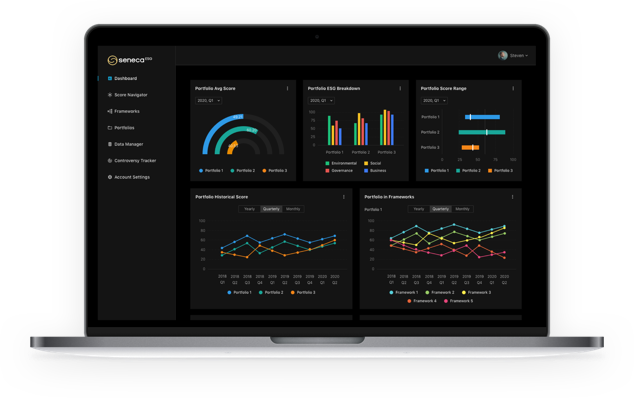カーボンオフセットは、基本的に温室効果ガス削減プロジェクトに対する投資である。個人や団体がカーボン・オフセットを購入する際、その取引資金は、自然生息地の保護、森林再生、農村地域向けのクリーンな調理用燃料など、脱炭素につながる環境・社会プロジェクトに充てられる。その見返りとして、カーボン・オフセット購入者は、炭素削減量に比例したクレジットを受け取る。通常、カーボン・オフセット1クレジットは、二酸化炭素換算で1トン(tCO2e)の温室効果ガスを排出する。
持続可能な未来へのコミットメントを示すために、多くの組織がネット・ゼロ誓約を行ったか、行う意向を示している。2022年には、MSCI ACWI IMIインデックス(先進国および新興国のあらゆる規模の上場企業9235社を対象)の3125社が何らかのネット・ゼロ誓約を発表しており、ネット・ゼロ目標を掲げる企業の割合は着実に増加している。しかし、多くの産業(農業、航空、建設など)では、事業やバリューチェーンにおける排出削減だけでは、排出量を完全に中和することはできない。それを補うために、炭素回収・貯留(CCS)技術や自然を利用した貯留など、炭素の除去が適用され、下のグラフにある科学的目標イニシアティブ(SBTi)のように、緩和しきれなかった残留排出を軽減することができる。ゼロから除去プログラムを実施することは、多くの企業にとって財政的に非現実的であるため、カーボン・オフセットは、ネット・ゼロ経路の最後に炭素除去のニーズを満たす最も単純で効率的な方法である。

ビジュアルの出典:科学的根拠に基づく目標イニシアティブ
購入者がオフセット・プログラムの選択に注意を払わなければ、その貢献による炭素除去効果が著しく損なわれる可能性がある。信用されていない炭素クレジット・プログラムに参加すれば、その企業は「グリーンウォッシング」(根拠のない環境主張のマーケティング)に関与することになり、風評リスクや規制リスクにさらされることになる。したがって、カーボン・オフセットの信頼性と品質を確保することは、リスクを最小限に抑えるために不可欠である。
適切なオフセット・プログラムを選ぶには?
企業のネット・ゼロ運動の本質は、ビジネスモデルを持続可能な方向にシフトさせ、あらゆる産業で排出量を削減することである。原則としては、企業はカーボン・オフセットに取り組む前に、常に自社の排出量削減を優先すべきである。これはまた、カーボン・オフセットは暫定的な炭素目標達成のために利用されるべきではないことを意味する。SBTiのネット・ゼロ基準によれば、カーボン・オフセットは、企業のベースライン排出量の10%以上を中和するために適用されるべきではない。すべてのカーボン・オフセットは、事業活動を脱炭素化するための具体的な行動を先行させるべきであり、決して従来どおりの事業を継続するための正当化として扱うべきではない。
企業は、事業活動やバリューチェーンにおいて削減が可能な範囲で排出量を削減し、カーボン・オフセットによって残余排出量を中和する準備が整ったら、カーボン・クレジットが具体的な気候変動への影響に変換されることを確実にするために、オフセット・プログラムの信頼性と質を注意深く評価する必要がある。カーボン・オフセット・プログラムを吟味する際には、いくつかの重要な特徴がある:
- 包括的かつ継続的な情報開示による透明性
信頼できるカーボン・オフセット・プログラムの特徴は、高い透明性である。カーボン・オフセット・プロバイダーは、プロジェクトの温室効果ガス削減効果を定量化するための方法論を公に開示すべきである。方法論は、プロジェクトの境界の定義、ベースライン排出量の算定、評価指標、およびプロジェ クトの寿命の決定について詳細な説明を提供すべきである。事業者は、エネルギー効率、炭素回収・利用、地域森林管理、メタン削減など、事業が属する様々な影響カテゴリーに対応する方法論を持つべきである。また、価格設定モデルも明確に説明され、一般に公開されるべきである。
コンプライアンス目的の場合、組織は、検証済みのカーボン・クレジットを、国内、国際、または公認のオフセット・プログラムから調達することが推奨される。
- 長期的な貯留を確保するための自然炭素吸収源の管理
企業は一般的に、マーケティング上の魅力から、自然ベースのオフセット・ソリューションに惹かれる。自然ベースのオプションの中で最も人気があるのは、植林である。このようなプロジェクトは、森林の炭素除去効果がよく理解されていることから、一般に広く受け入れられている。しかし、森林をベースとしたオフセットによる影響の定量化は、しばしば過度に単純化されている。森林は、多くの自然ベースの炭素吸収源と同様に、山火事、害虫、病気、伐採、土地転換など、適切に管理されなければ、短期間で炭素を大気中に放出する可能性がある。一方では、カーボン・オフセット・プログラムは、自然資産の管理を怠ることによって過ちを犯し、自然資産を高い損害リスクにさらすことになり、その結果、これまでのすべての努力を無効にしてしまう可能性がある。一方、自然を利用した炭素除去のほとんどは、植物が成熟し環境が安定するまでに長い時間を要する。この過程で、植えられた木の一定割合が生き残れない可能性もある。したがって、自然をベースとしたオフセットを選択する際、組織はプロジェクトの寿命、影響指標、方法論に特別な注意を払う必要がある。寿命が長く(できれば10年以上)、生態系保護区の厳格な継続管理が実証されているプロジェクトを選ぶこと。
- 地元コミュニティの全面的なプロジェクト参加
ほとんどのカーボン・オフセット・プロジェクトは、公衆衛生、女性のエンパワーメント、経済的機会など、地域コミュニティにさらなる社会的・経済的影響を与える。適切に設計され、実施されたオフセット・プロジェクトは、「害を与えない」という原則を厳守し、カーボン・オフセット・プロジェクトから創出される機会へのアクセスが地元の利害関係者を優先することを保証すべきである。これを確実にするために、企業は、プロジェクト全体を通じて地元コミュニティが積極的に関与していることを実証できるオフセット・プログラムを探すべきである。例えば、プロジェクトは、明確に地元の請負業者と協力し、地元の専門家を雇用しているか?受益者は、プロジェクトから直接支払いを受けているか、また、そのような支払いに充てられる資金はどの程度か。この特定のプロジェクトのアイデアは、もともと地元の人々によって提案されたものなのか?これらは、カーボン・セッティング・プログラムの影響力を測定し、その透明性と有効性のレベルを理解するために、組織がカーボン・セッティング・プログラムに尋ねるべき質問のサンプルに過ぎない。
情報源
https://verra.org/methodologies-main/
https://www.goldstandard.org/resources/faqs
https://sciencebasedtargets.org/resources/files/Net-Zero-Standard.pdf
https://www.smithschool.ox.ac.uk/sites/default/files/2022-01/Oxford-Offsetting-Principles-2020.pdf




